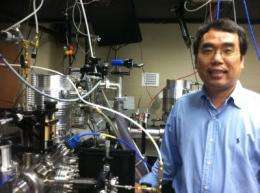67-attosecond extreme ultraviolet laser pulse is the world's shortest

A University of Central Florida research team has created the world's shortest laser pulse and in the process may have given scientists a new tool to watch quantum mechanics in action – something that has been hidden from view until now.
UCF Professor Zenghu Chang from the Department of Physics and the College of Optics and Photonics, led the effort that generated a 67-attosecond pulse of extreme ultraviolet light. The results of his research are published online under Early Posting in the journal Optics Letters.
An attosecond is an incomprehensible quintillionith of a second. In other words it would take 15 million billion pulses of the size Chang's team achieved to equal one second. The accomplishment is even more remarkable because the team did it without the use of specialized equipment including a mile-long particle accelerator or a Superdome-sized synchrotron.
"Dr. Chang's success in making ever-shorter light pulses helps open a new door to a previously hidden world, where we can watch electrons move in atoms and molecules, and follow chemical reactions as they take place," said Michael Johnson, the dean of the UCF College of Sciences and a physicist. "It is astounding to imagine that we may now be able to watch quantum mechanics in process."
Quantum mechanics is the study of physics at the microscopic level, specifically looking at energy and matter on this miniscule scale.
There is much excitement about the accomplishment and the promise Chang's work holds for helping scientists understand how the world's smallest building blocks actually work. The technique could lead scientists to understand how energy can be harnessed to transport data, deliver targeted cancer therapies or diagnose disease. The finding marks the first significant breakthrough in the laser pulse field in four years.
In 2001, attosecond pulses were demonstrated for the first time. Since then scientists around the world have been trying to make ever-shorter pulse durations because of the door they could open to understanding the subatomic world. The previous record of an 80-attosecond pulse was set in 2008 at the Max Planck Institute in Garching, Germany. This is the first time an American-led team has set the record.
"The quest for generating shorter and shorter pulses of light has been ongoing since the invention of the laser more than five decades ago," said Bahaa Saleh, dean of CREOL, the College of Optics and Photonics. "Dr. Chang's recent advance brings UCF to the forefront of this Olympic race and opens up new frontiers for seeing and recording ultrafast dynamic atomic phenomena."
Chang's team was able to accomplish the work at the Florida Atto Science &Technology (FAST) lab in UCF's Physical Sciences building.
Using the unprecedented power of laser light enables Chang and his peers to conduct their high-level research in much smaller spaces. Chang's group created a technique called Double Optical Grating that allows extreme ultraviolet light to be cut off in a manner that concentrates the maximum amount of energy in the shortest possible pulse of light. With the affinity for acronyms shared by many ultrafast laser physicists, Chang named the technique DOG. In addition to creating the light pulse, he created an even faster camera to measure it, which is the Phase Retrieval by Omega Oscillation Filtering (PROOF).
Journal information: Optics Letters
Provided by University of Central Florida



















